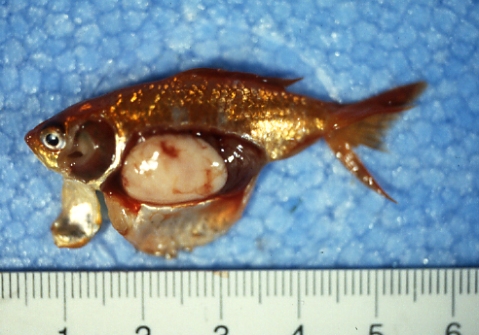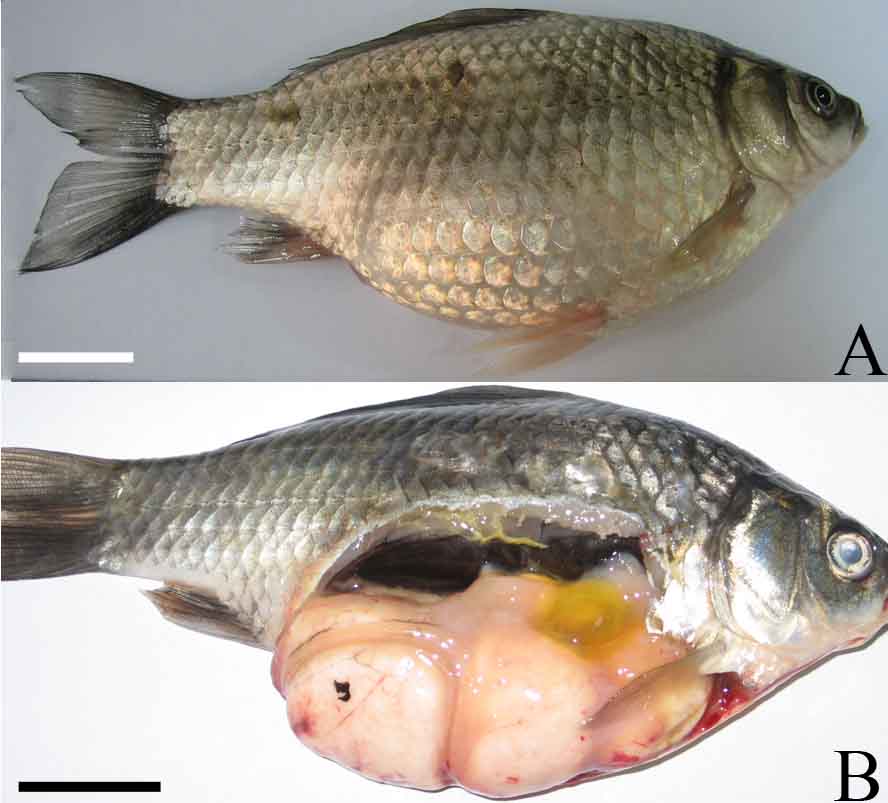
| Parasite | Myxobolus wulii |
|---|---|
| Taxonomy | Myxozoa, Myxosporea, Bivalvulida |
| Hosts | Crucian carp, goldfish (Carassius auratus) |
| Infection site | Hepatopancreas, gill |
| Clinical signs | There are two types of infection with M. wulii; one is observed in the hepatopancreas, while the other is in the gill. Fish infected in the heapatopancreas exhibits abdominal swelling and dies chronically. The peritoneal cavity is filled with enlarged hepatopancreas (Figs. 1 and 2). In branchial infection with M. wulii, a number of white dot-like cysts develops in the gill, resulting in mass mortalities of host fish. |
| Parasitology | Numerous spores are produced inside the cysts (Fig. 3). A spore (length 17 (15-18) mm; width 10 (9-12) mm; thickness 8 (7-9) mm) is oval and has 2 polar capsules (length ca. 8 mm; width ca. 3 mm). This parasite was originally described as Myxosoma magna, infecting the gill of goldfish in China, but after synonymization of Myxosoma with Myxobolus, it was renamed as M. wulii (Landsberg and Lom, 1991). |
| Pathology | Large cysts extended the neighboring gill filaments, disturbing their normal arrangement, causing obstruction of the blood flow and fusion of gill filaments (Yokoyama et al., 1992). |
| Health hazard | Since this parasite is not infectious to human, it is harmless in food hygiene. |
| Diagnosis | Check the spores by the wet-mount of squashed cysts. Sample should be smeared and stained by Giemsa or Diff-Quik. |
| Other information | This parasite is also reported in the hepatopancreas of crucian carp in China (Chen and Ma, 1998). It is unknown why it shows 2 types of infection site. Though both types are regarded as the identical species by their morphological similarity, it is necessary to clarify their relationship by DNA analysis. |
| References | Chen, Q. L., and C. L. Ma (1998): Myxozoa, Myxosporea. Fauna Sinica. Beijing,
Science Press, 987 p.
Landsberg, J. H. and J. Lom (1991): Taxonomy of the genera of the Myxobolus/Myxosoma group (Myxobolidae: Myxosporea), current listing of species and revision of synonyms. Syst. Parasitol., 18, 165-186. Wu, B.-H. and Z.-F. Li (1986): Six new species of myxosporidian from freshwater fishes in Zhejiang Province (China). Acta Zootaxonomica Sinica, 11, 1-9. Yokoyama, H., K. Ogawa and H. Wakabayashi (1992): Branchial pathology of cyprinid fish infected with two myxosporean parasites. In eDiseases in Asian Aquaculture (eds. by M. Shariff, R. P. Subasinghe and J. R. Arthur)f, Fish Health Section of Asian Fisheries Society, Philippines, pp. 337-343. |

Fig. 3. Fresh spores of M. wulii from the hepatopancreas of goldfish.


Fig. 1. Goldfish infected with Myxobolus wulii in the hepatopancreas
(Photo by Jin-Yong Zhang (2))